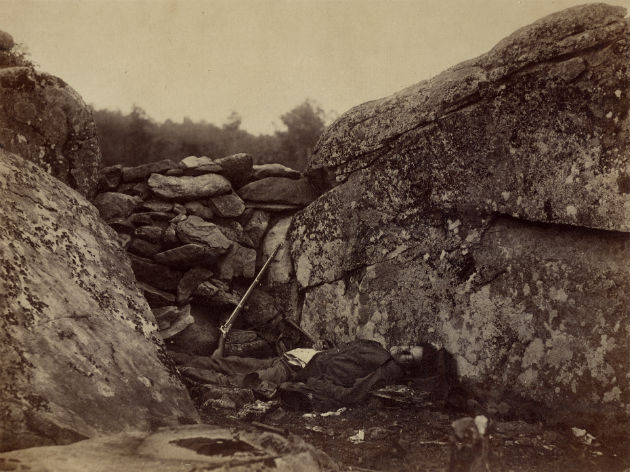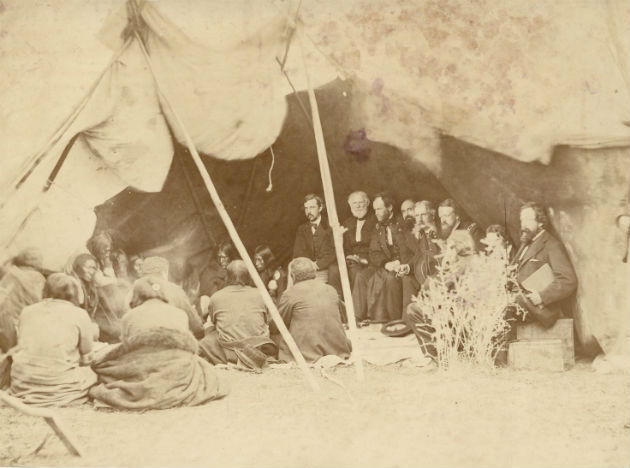Like peanut butter without jelly, coffee without a cigarette, or burgers without beer, the curators of the National Portrait Gallery’s ‘Dark Fields of the Republic’ seem to believe that these remarkable 19th century photographs by Alexander Gardner are incomplete without a generous pairing of moral indignation. The most dramatic example I can offer is the commentary that accompanies one of Gardner’s most famous pictures, A Sharpshooter’s Last Sleep, taken at Gettysburg soon after the conclusion of hostilities. It has been established for years now that Gardner staged the shot (among some others) macabrely dragging a dead Confederate into a more picturesque spot and pose.
Now, a photographer really shouldn’t do this sort of thing, but you might think that 150 years is sufficient time to allow a balanced approach to the issue. After all, Gardner was far from the only guilty party when it came to manipulating images—the founder of battlefield photography, Roger Fenton, was not above moving the odd cannonball around the Crimea in order to achieve a better picture.
But humility and perspective aren’t this exhibition’s strengths. Gardner’s actions, according to the commentary that accompanies the photograph, were an "intrusion" that is "unforgivable from both a moral and artistic point of view." Yeesh. "That this photographic construction would be more marketable to a public still steeped in Victorian sentimentality only adds to Gardner’s malfeasance." Uncle, your Honor! Alexander Gardner throws himself upon the mercy of the National Portrait Gallery!
This sort of thing isn’t just distracting. It also seems weirdly ignorant of the fact that, while professional war photographers in 2016 generally aren’t propping up corpses whenever it suits them, there is still plenty of room for shading the truth in that trade. Consider that a journalist with a digital camera can take thousands of shots while documenting a single day of combat in Iraq or Afghanistan. Of these, perhaps a few dozen images are highlighted for an editor in New York or Washington as being especially worthwhile, and one or two get selected for publication. Almost invariably, those images that make it to print will be selected not only because they are visually arresting, but because they illustrate a preconceived notion that the editor has in mind about how the fighting is proceeding. Things going well? A soldier smiling in the company of local children will do. Things going poorly? Find a soldier with a thousand-yard stare—even if the expression is, in reality, because the subject is having an absent-minded moment or has a cold. This sort of thing is manipulation, too, and it happens in newsrooms every day.

None of this forgives Gardner’s deception, but some humility and reflection on the part of the exhibition would be less jarring. For all of the information that it conveys, the commentary too frequently takes on the quality of an ill-tempered Sunday school teacher letting you know when to feel disapproval. Basically, you should feel very bad about actions taken by the U.S. government. The hanging of the Confederate superintendent of the hellish Andersonville prison camp happened after "a trial that was notably unfair and biased." The man was not guilty of murder, in the opinion of the curators, but was "simply overwhelmed—and possibly incompetent." Any conflict between settlers and American Indians (Gardner, on contracts from the federal government and the railroads, also photographed much of the West) was always and wholly the fault of the newcomers—but at least Gardner managed to take some "dignified likenesses of a resistant people" along the way, even if some of those shots were intended "to document the supposed salutary benefits of the sitter’s exposure to American Civilization."
This constant hectoring and moral posturing is a shame, because in other respects this is a fascinating and worthwhile show. Gardner led quite a life, much of which remains mysterious to us. Born in Scotland, he worked at times as a jeweler and a banker. There is some talk of involvement with socialism, and it appears he was involved in plans for establishing a utopian colony in Iowa. He arrived in the United States only a few years before the war, and became Matthew Brady’s most trusted assistant. Striking out on his own, he set up a studio in Washington at 7th and D and became known as Lincoln’s favorite photographer.
Eventually he chucked it all in and finished out his days working in insurance. The exhibition displays two solo self-portraits taken during the ’60s, and in both of them Gardner is elaborately dressed, even costumed, first as a frontiersman, complete with furs and a bow, and second as an East Coast dandy. Is it too much to hope that the Great Gatsby reference with which this exhibition is named was selected as a nod to the fact that Gardner was a Gatsby-type himself, self-made, an adventurer, performer, and a bit of a scoundrel?

A number of these photographs are so iconic that a visitor might be surprised to learn they were all taken by the same man. This quality applies especially to the portraits of Lincoln, and of these the famous "cracked plate" image most of all. The curators aptly note that the picture was a "departure from Gardner’s usual crisp empiricism"—but it suits our modern tastes and gives us an otherworldly Lincoln, a couple of months before his death, his creviced face pushing into the plane of focus. It seems that because of the crack, Gardner threw the original plate away, so only a single version of the portrait exists. Lincoln displays a modest smile, into which we can read what we like—given the entirely unusual quality of the portrait, maybe he was just smiling at Gardner’s frustration as things went wrong.
Many of Gardner’s less famous images also have an arresting quality, like the group portrait he shot of a visiting delegation of Japanese noblemen, dressed in their warrior best and looking hard, deeply worn, and ill-at-ease in the capital of a commercial empire—or like the Catholic priest giving Mass to the troops at a fort in what is now Rosslyn. Neither image has a spot in the stereotypical visual vocabulary of the period, and both help one to reimagine more fully what that world really looked like.
Gardner, like his mentor Brady, like Fenton, and like Charles Marville, was a pioneer of an art form that promised to aid in just such a re-imagining. Sometimes he lied a bit, apparently in order to be more certain of making a buck, or to push an idea that wasn’t in immediate visual evidence. It is an interesting story—and like any story, it is better when told without the tone of prim self-satisfaction.
